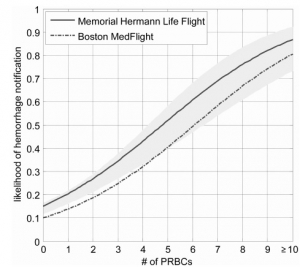12/01/2016
Prédire le besoin transfusionnel tôt ?
Automated analysis of vital signs to identify patients with substantial bleeding before hospital arrival: a feasibility study
Liu J et Al. Shock. 2015 May;43(5):429-36.
---------------------------------------------------------
Dépister un saignement significatif à partir des éléments standards de monitorage préhospitalier serait possible à en croire cet article. Il existe actuellement un grand nombre de recherche dans ce domaine. A suivre.
---------------------------------------------------------
Trauma outcomes are improved by protocols for substantial bleeding, typically activated after physician evaluation at a hospital. Previous analysis suggested that prehospital vital signs contained patterns indicating the presence or absence of substantial bleeding. In an observational study of adults (aged Q18 years) transported to level I trauma centers by helicopter, we investigated the diagnostic performance of the Automated Processing of the Physiological Registry for Assessment of Injury Severity (APPRAISE) system, a computational platform for real-time analysis of vital signs, for identification of substantial bleeding in trauma patients with explicitly hemorrhagic injuries. We studied 209 subjects prospectively and 646 retrospectively. In our multivariate analysis, prospective performance was not significantly different from retrospective.


The APPRAISE system was 76% sensitive for 24-h packed red blood cells of 9 or more units (95% confidence interval, 59% Y 89%) and significantly more sensitive (P G 0.05) than any prehospital Shock Index of 1.4 or higher; sensitivity, 59%; initial systolic blood pressure (SBP) less than 110 mmHg, 50%; and any prehospital SBP less than 90 mmHg, 50%. The APPRAISE specificity for 24-h packed red blood cells of 0 units was 87% (88% for any Shock Index Q1.4, 88% for initial SBP G110 mmHg, and 90% for any prehospital SBP G90 mmHg). Median APPRAISE hemorrhage notification time was 20 min before arrival at the trauma center. In conclusion, APPRAISE identified bleeding before trauma center arrival. En route, this capability could allow medics to focus on direct patient care rather than the monitor and, via advance radio notification, could expedite hospital interventions for patients with substantial blood loss.

Les commentaires sont fermés.